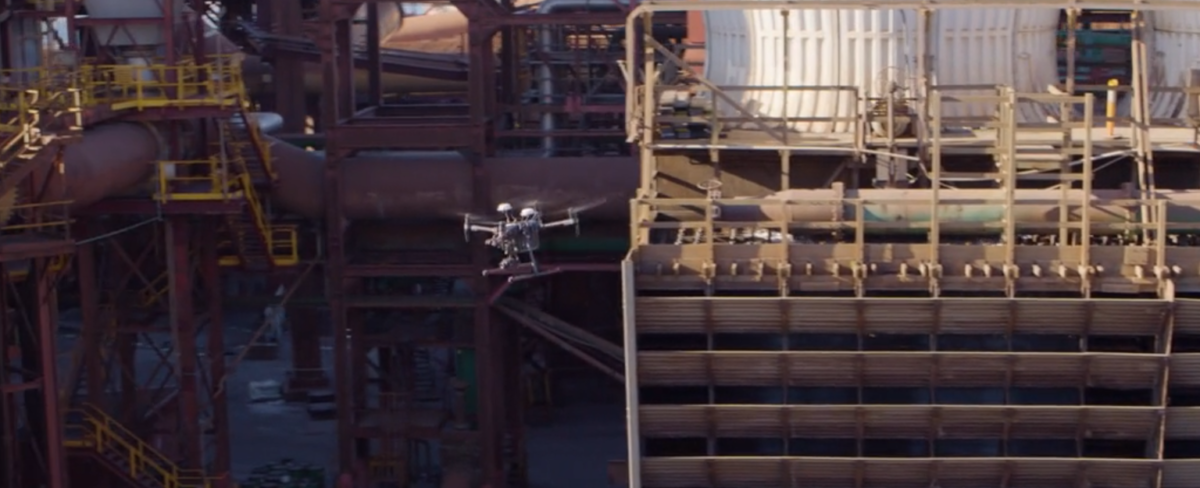
We’ve been at the forefront of using drones for engineering applications for some time. Now we’re giving mining, heavy industry and construction a much faster and safer means to inspect or audit dangerous and inaccessible areas via the use of the innovative technology.
We’ve partnered with aerial photography specialist Flying Robot to use remotely piloted aircraft (drones), with inbuilt redundancies and the latest in imaging tech to carry out inspections. This has largely eliminated reliance on teams of personnel, rigging or scaffolding and the inherent dangers involved. In addition, the time-saving benefits offers a more streamlined and consistent process with clear, objective results. And importantly, the use of drones is delivering huge value to our clients with significant cost savings and the near-elimination of shutdowns for plant audits.
We got the low down from our Chief Operating Officer, Jim Allan. “Heavy industrial and mining environments, for instance, are harsh on both the service personnel and equipment, plus the downtime associated with audit work can be a very expensive exercise”.
“Safety of the people involved is always at some sort of risk as inspection procedures normally involve an element of physical danger”.
“Then, there are cases where the overall condition of structures on some sites is perpetually overlooked because access is difficult, dangerous and expensive for operators and auditors.”
Our association with Flying Robot has opened up new avenues of inspection across a range of industries including, but not limited to, civil engineering, mining, bulk material handling and forensic engineering as well as services to the manufacturing and minerals processing sectors.
Having worked at length to develop a team of experienced and skilled operators, SOTO Flying Robot are able to achieve in a single day what would take a week with more traditional methods.
The drone is operated remotely at a safe base on the ground by a fully certified Flying Robot pilot alongside a SOTO engineer viewing a FullHD monitor in real-time during the inspection exercise – the safety implications of a two person team are wide ranging, however, the result of using a skilled pilot in combination with a qualified engineer directing the image capture also ensures that the results, whether they be thermal images, high resolution digital still images or video are informative and effective tools for audit.
Structures already inspected by Flying Robot include bridges, exhaust stacks, roads, elevated conveyors, transmission lines and water towers. We also have the technical skills and abilities to create an inspection solution for structures which fall outside these asset types.
“Statutory structural audits in the coal mining sector will be one of the real beneficiaries of our new solution,” says Jim.
“The mining industry requires these audits to be undertaken annually to locate potential hazards arising through vibration, stress fatigue or corrosion.
“The current types of audits presently consume significant man hours. Often difficult access and terrain preclude many structures from complete inspection and the true condition of the structure or plant remains unseen and unreported possibly for years, thus giving rise to hazardous issues and expensive consequences.”
Flying Robot director Glen McGarry says, traditional methods of site inspection often involves a large team of people, considerable OH&S induction and familiarisation, and a lot of time to complete.
“Whereas traditionally there has always been a risk of persons and contractors getting injured, the use of drones minimises this risk especially when operating at height or within confined spaces. “For example, the legal height limit for us to fly a drone is 122m, so to inspect a smoke stack we simply fly the drone straight up from the ground to our maximum height, whereas before this involved personnel on ropes coming in from the top, or operating specialist cranes alongside with limited availability and at high cost, which is slow and putting lives at risk.” Our task with SOTO is to photograph or video the infrastructure in a systematic manner to document the structure and make an assessment,” said Mr. McGarry.
Flying Robot is a licensed commercial drone operator by the Civil Aviation Safety Authority (CASA) for the provision of all its services. The company has offices in Sydney, Melbourne, South Australia, and Brisbane. With these office bases their specialist teams cover all of Australia.
“In the hands of an accredited expert, a drone can be mounted with a camera of choice (24 megapixel high resolution, with real-time zoom function or 42MP, highest resolution, fixed lens), positioned to hover in the air at any chosen holding point, take as many photographs as required which are then analysed by SOTO engineers back at the office. “Therefore, the team can easily work out what sort of remediation is required without sending a single human being into the danger zone. Importantly, in real-time via the FullHD live camera feed to the ground, the attending SOTO engineer can direct the team to focus on a specific area of interest as a hazard is identified” Mr. McGarry added.
“If you use a cherry picker, to be safe, it requires a very flat and stable base directly beneath, but most industrial sites are not like that. To the drone it doesn’t matter – it will safely take off from almost any surface.”
If you’re interested to find out more about our Flying Robot statutory auditing capability get in touch via the contact form and we’ll get straight back to you.


